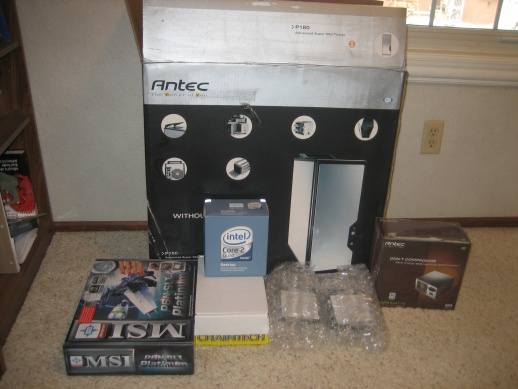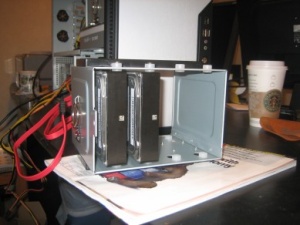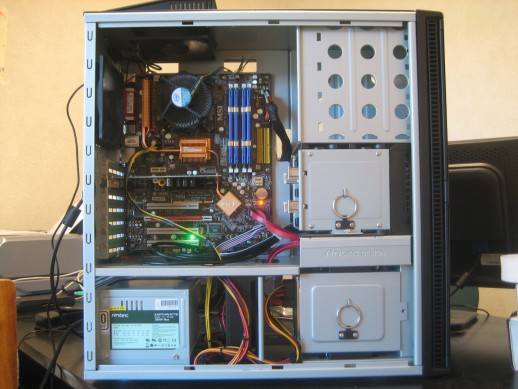Most enthusiastic programmers start out as over-engineers. It’s a side effect of caring deeply about our craft. With experience we learn that simplicity is king and less is more, but it takes effort. That’s why I love a quote by Ferdinand Porsche, who designed the original VW Beetle and started the Porsche company, that says:
The perfect race car crosses the finish line in first place and then falls to pieces.
After I first heard it from a car fanatic good friend, the quote went straight to my wall. If I start gold plating code or requirements, there’s Dr. Porsche to whip my ass back into pragmatism. But no other time is more trying than when I’m building a computer. I just need a RAID 10 array, a quad-core Core 2 Extreme, and 16 gigs of 2-cas-latency RAM! Of course, in a disciplined frame of mind such largesse is simply gross over-engineering. And it’s more fun and challenging to seek an optimal performance/money ratio than to buy your way out of thinking.
Or maybe that’s just what I tell myself when I only have $1,000 bucks to spend. Either way, multi-core CPUs made powerful computers far more affordable. You can build a fine quad-core, 8-gig server within that budget. In my case I wanted a VMware rig to power this website. I talk to other people who are interested in setting up a VMware lab to learn different technologies, yet feel discouraged due to server prices. But building your own server can save 50% off the price for a similar Dell product. When I priced a PowerEdge tower comparable to my custom build, it came out at $1,900 for the Dell versus $930 for custom. That’s actually a good deal for a business. But for home users, building our own is often the best (or only) option. So here is my parts list, along with some tips:

Build parts
[Update: The server has now been running for about 3 months with continuous uptime (a single reboot). No problems that I know of. However this parts list is about 3 months old and could be improved upon. Take a look at the comments section as people made good suggestions. Here are some ideas: 1) AMD CPUs might be a good way to go, freeing up some money to spend on perhaps more disks, 2) a cheaper motherboard (hopefully with integrated video) would be fine, provided it's a good brand, 3) stick with 16MB-cache hard disks. Just make sure to check the NewEgg reviews: see what people are saying, the overall rating, and the percentage of one-egg reviews (ie, people who hated it). Then read some of the one-egg reviews to find out what the problems are. If they're complaints about Dead On Arrival (DOA) products, then you should be ok since every product has those; but if something more sinister is going on, stay out. If you're going to run Linux, Google quickly for the motherboard name + "Linux" to see what people are saying. Don't trust editor reviews: always check out what the people say. Vox populi, vox dei.]
| Component | Part | Price |
| Motherboard | MSI P6N SLI Platinum LGA 775 NVIDIA nForce 650i SLI ATX Intel Motherboard – Retail
This is a top-quality motherboard, but make sure you upgrade the BIOS to the newest version. They ship with a buggy BIOS which crashes the machine after the BIOS post when you install four 2-gig RAM modules. This happens for many RAM brands and took 2 hours to track down, the biggest time sink in this build. After upgrading the BIOS all is well. I left the machine running memtest86 for a day and a half with no problems. The motherboard works well in Linux, but there are some quirks with stock distro kernels due to the newish chipset. As usual Ubuntu had the best support, but HPET is not working. I disabled it in the BIOS for now to prevent "lost some interrupts" log messages. lm-sensors only retrieves CPU core temps and nothing else (in CentOS, lm-sensors didn’t work at all). I’ll look into both of these issues later, but they’re minor annoyances: overall everything works well; HPET is useless anyway. |
$139.99 |
| CPU | Intel Core 2 Quad Q6600 Kentsfield 2.4GHz LGA 775 Quad-Core Processor Model BX80562Q6600
I don’t normally overclock. Most workloads aren’t CPU-constrained and overclocking often adds cost and headache to little practical advantage. By not overclocking we can use the stock heatsink that comes with the processor, saving some money. My idle core temperatures are at ~30oC; they peaked at ~60oC after a day of Prime95 (one instance per core) with no errors. These are fine temperatures, no need for a 3rd-party heatsink. |
$254.99 |
| Case | Antec Performance One P180 Silver cold rolled steel ATX Mid Tower Computer Case – Retail
This is a glorious case, but I only bought it because it was on sale for $89.99. It’s pleasurable to work with a good case, but really, you only work with it for one hour while you build the computer. Again, if you’re not overclocking and hence not worried about whether a degree Celsius will corrupt your file system, you can safely buy in the $50-$80 range. Stick to cases without power supplies though, since bundled power supply units are usually crap. |
$129.99 |
| Power Supply | Antec earthwatts EA380 ATX12V v2.0 380W Power Supply – Retail
People go overboard on power supply wattages. There’s no reason to. All you get for idle wattage is a higher electrical bill and a warmer planet. This is a good-quality, energy-efficient (80+ certified) power supply with plenty of juice for our server. Perfect. Adjust accordingly if you have power-hungry video cards or peripherals to be fed. Always buy a good power supply unit. Power supply problems are disastrous: 1) they can fail and bring your server down, 2) they destabilize and crash the computer, and 3) they fry all your other components. Be economical on the wattage but not on quality: stick to good brands and check the Newegg reviews. |
$59.99 |
| RAM | G.SKILL 4GB(2 x 2GB) 240-Pin DDR2 SDRAM DDR2 800 (PC2 6400) Dual Channel Kit Desktop Memory Model F2-6400CL5D-4GBPQ – Retail Great reviews on newegg (5 eggs, 2% 1-egg rate), passed multiple passes of memtest86 for me. It’s a winner. |
$79.99 * 2 = $159.98 |
| Video Card | EVGA 256-P2-N297-LX GeForce 6200LE TC 512MB (256MB on board) 64-bit GDDR2 PCI Express x16 Video Card – Retail I look for two things in video cards: fanless cooling and low power consumption. Fans move, therefore they make noise and fail. You can avoid both with a heatsink-only card. They also tend to draw less power. This one runs cool, supports 2 monitors, comes with an S-cable and DVI adapter, and costs 7 lattes. |
$27.99 |
| Hard drives | Western Digital Caviar SE WD3200AAJS 320GB 7200 RPM 8MB Cache SATA 3.0Gb/s Hard Drive – OEM
Disk I/O is the most common bottleneck I find when troubleshooting server performance. It’s also the subsystem most affected by virtualization. In fact, CPU and RAM work basically at the same speed in the host and guest. But disk suffers for many reasons. So we go with 2 hard drives. The perfect car breaks apart after the race, but it finishes in first place. This drive is a solid 5-egger (hahah) with only 2% 1-egg ratings. I trust WD as much as any other. Unfortunately, this was not the drive I bought, but it’s what I would buy now. I bought the SAMSUNG SpinPoint T Series HD501LJ 500GB 7200 RPM 16MB Cache SATA 3.0Gb/s Hard Drive – OEM for $105. It’s a 5-egg drive too but it has 8% 1-egg ratings, several of which are complaining about failure after a few months. That’s much worse than a drive being dead on arrival. Now I live in phear of my hard disks going bust on me. Yay for Linux software raid. |
2 * 72.99 = $145.98 |
| TOTAL | $918.91 |


This hard drive drawer is a nice touch in the Antec P180. The white rubber things help damp hard drive noise.
I never buy CD/DVD drives or floppy drives. I have a USB Lite-On DVD reader/burner and a USB Sony floppy disk. I’ve used them for years on countless computers, installed all the OSes, flashed the BIOSes, never had a problem. It’s a great solution. You can save money on every computer, plus no worries about powering a DVD burner off your power supply.
For a home server, especially one running VMware, I recommend a simple Uninterruptible Power Supply to prevent file system corruption. VMware is particularly sensitive (I have a detailed entry coming up on this). Since this type of corruption can cost hours and I only have a few hobby hours a week, I’m more than willing to pay for an UPS. I really like this APC unit. If you buy one, make sure you set everything up so that the computer really shuts down if power is lost, otherwise you’re just running a $100 LED display.

Here’s what the full build looks like
The computer runs silently. In fact it’s two feet away from me right now, case open, and I can hardly hear a thing. Assembly time for this box was about one hour. I wasted another two hours figuring out why it crashed with 8 gigs of RAM. Fixing the problem was a matter of minutes: I just flashed the motherboard BIOS and it was cured. And that was the easy part of getting the server up and running. I’ve since been doing some experiments on file system and virtual machine performance, which takes a lot more time than plugging connectors together. I should have some results over the weekend.
Update on 2008-12-23: Doug Holton has posted a new parts list for a quad core server, now down to $500 with 1 TB of storage.